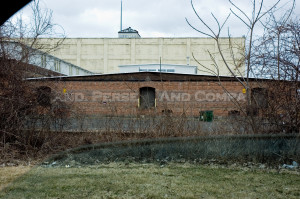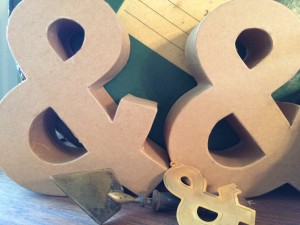
Hoxsie has often referred to Albany as “The City Without a Nickname.” Other than “The Capital City,” other nicknames that it may have deserved – “The Piano City,” “The Celluloid City,” “Drainage Basin of the Erie Canal” – never quite stuck. But one of its ephemeral nicknames should have stuck, because without its contributions, the modern age of commerce could never have happened. Albany was once the center of manufacture and home of a progressive movement that freed a powerful symbol for use in commerce, and thus should be known as “The Ampersand City.”
In colonial times, the ampersand was considered a luxury item; no one actually needed them, and those who wanted them were prepared to pay dearly. And so for the first couple of centuries, ampersands were imported items. Ampersands were treated very much like windowpanes, which were enumerated and taxed individually, and only the most successful businesses could afford to proclaim themselves as “Gray & Sons” instead of using the more pedestrian “Gray and Sons.” In addition to paying an annual tax to the locality, ampersand holders paid for each use, and the actual physical item – a big wooden “&” for a factory sign, for example – could cost hundreds of dollars at a time when workers made pennies a day. This lasted well into the 1800s, a growing time of commerce in the United States when all kinds of businesses were proclaiming themselves in ways that would have benefited from the ampersand. Those who held the rights to import them kept a stranglehold on supply, and domestic craftsmen who knew how to make them were virtually non-existent, until a plucky Albany businessman made the ampersand an item of mass production.
Andrew Persé was born to an otherwise unnoticeable Albany family in Sheridan Hollow around 1840. He was early apprenticed as a clerk to Bacon, Stickney & Co., a very prestigious importer of coffee and spices that did such a business it had two stores side by side on Dean Street and another on Exchange. Not only did they have an ampersand in their name, but merchant baron Samuel Bacon held the license for importing ampersands for all of New York and western Massachusetts. Any business, any printer, any signpainter who wished to make use of that single character in place of three, and convey all the prestige that carried, had to make payment to Bacon.
Bacon was a profiteer and influential. A national craze for abbreviation was already under steam when the Civil War came, and the need for brevity in letters to and from the Union soldiers threatened his hegemony over the ampersand symbol as it became possible the owners of these exclusive rights would simply be overrun by popular use. If everyone started using the ampersand, it would be impossible to collect the fees. But Bacon hit on a brilliant and very New York scheme, convincing one of the legislators he owned to get legislation passed that established a tax (which Andrew Persé went off to fight). He was able to get a law through the Legislature that established a postal surcharge for the presumed use of ampersands in correspondence. Nevermind that it was certain that New York’s law would be, and eventually was, found to unconstitutionally intrude on Federal jurisdiction. It stood long enough to make Bacon even more ridiculously wealthy, all based on the legal presumption that each letter-writer would use an ampersand at least once per letter.
Persé, serving in the Army of the Potomac and having worked for Bacon, was particularly galled by this turn of events, and frequently wrote home of his anger, in full longhand without abbreviation as a form of protest to his family. When he got back to Albany, something would be done. He used his spare time thinking about the mechanics, talking to men of practical experience, and working out how to amass the raw materials and machinery needed to modernize ampersand production. He had a vision of turning from the hand-crafted imports (still largely wooden and produced in Holland) to modern, iron-based ampersands crafted with steampower.
It happened that his company lieutenant and fireside chat-mate was Damien Van Rensselaer, evil half-brother of Stephen Van Rensselaer, who had money and a motive, to always serve as a thorn in the side of his half-sibling. DVR saw his opportunity in a stroke of genius: he would bankroll the creation of a modern factory on property he controlled just off the edge of the Lumber District in Albany – but, more importantly, immediately adjacent to the Van Rensselaer Manor.
With the war over, both returned to Albany and began their machinations. Persé hired a pair of Dutch brothers from a long line of ampersand makers to come to Albany, and DVR hired a crew of night masons to throw up a long, low brick factory within the sight line of the family estate. The activity was just far enough from the center of city activities that it wasn’t really noticed until smoke started pouring from its stacks, and it was then too late to be stopped.

Persé hired a wily salesman who went by the name of “Spats” Gansevoort, who offered the hitherto deprived factories, merchants and associations of Albany unbelievable cut-rate deals on ampersands; if they signed up before production began, they’d cost a tenth of what Bacon charged, and would be warranted to last forever, free of termites and dry rot. Even prosperous companies that already possessed ampersands were interested, and they were all guaranteed their money back if the plant failed to produce.
Flush with capital and orders, Persé’s factory immediately began producing ampersands of all shapes (well, really, just the one shape) and sizes, primarily of iron. Merchants from Troy, Schenectady, and even far-off Amsterdam soon heard of an alternative to Bacon’s extortionate prices, and were wiring orders in to the factory.
Of course, Bacon heard of all this, too, and was livid. He rushed to a local judge to get a cease and desist order, only to find the judge clearly in the pocket of Damian Van Rensselaer and unwilling to help. Racing up the hill to his legislators, he found that even they had become enamored of the idea of not paying for ampersands on the doors of their law practices – and they had some shiny new ones, fresh from what was called the “Andrew Persé And Factory.” Cleverly, Persé didn’t even use the word “ampersand,” just in case his scheme didn’t work and he ended up in hot water. He needn’t have worried.
The ampersand business just exploded. Boardman & Gray Pianos, Van Gasbeeck Carpets, Rugs & Curtains, Cotrell & Leonard clothing, Merten’s & Phalen’s – dozens of businesses started freely using the ampersand at Persé’s low, low prices. Bacon brought action in state court, but faced a platoon of lawyers from ampersanded firms who had taken up Persé’s case. Railroads, such as the Albany and Rensselaer and Kinderhook and Hudson Railroad, saw a real opportunity for savings and brevity, and loaned their considerable weight in the battle against Bacon. Desperate, he tried to cut costs, but importing remained more expensive than local manufacture, and his business collapsed.
But so did Persé’s. As he trained more and more workers to make the character, and machining equipment became standardized, some broke off and started their own ampersand factories on the edge of the Lumber District. The Erie Canal spread their wares to the west and south. For safety reasons, railroads had been barred from carrying ampersands, but a new act of the Legislature lifted that restriction and ampersands were carried on board when the transcontinental railroad opened. So was an itinerant ampersand-maker, who soon captured the business of the west. The profit soon went out of the business, as ampersands became more plentiful than water. When the bottom dropped out, Persé seems to have just disappeared.
The old ampersand factory still sits on the edge of the old Van Rensselaer estate. Damian Van Rensselaer continued to use it to vex his relations for some years, renting it for use by a clown college and, somewhat related, a calliope factory. After his death, it passed through a number of hands, but the faded sign on the railroad-track side of the building remains to this day.
